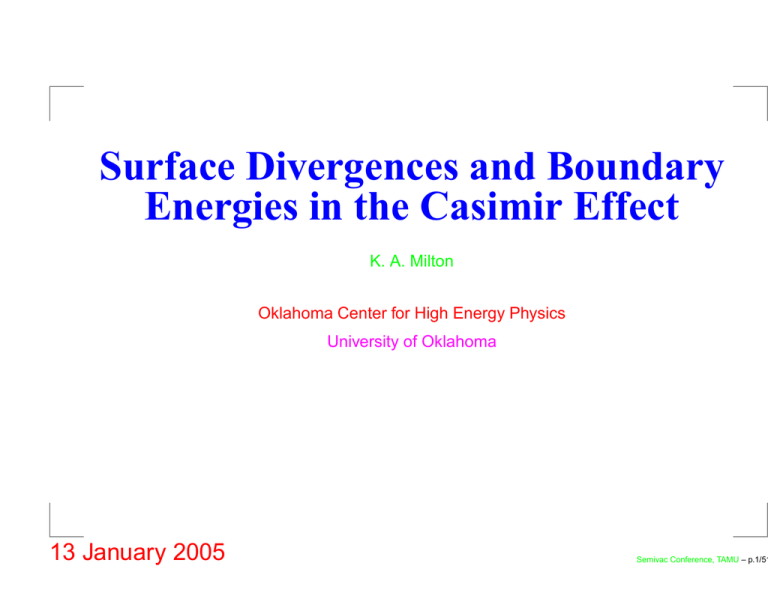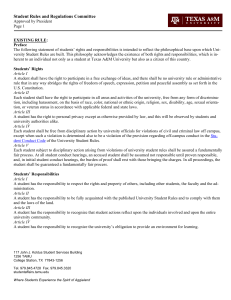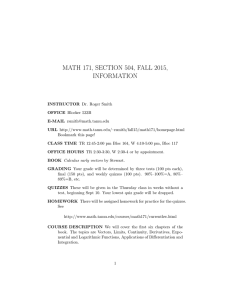Surface Divergences and Boundary Energies in the Casimir Effect 13 January 2005
advertisement

Surface Divergences and Boundary Energies in the Casimir Effect K. A. Milton Oklahoma Center for High Energy Physics University of Oklahoma 13 January 2005 Semivac Conference, TAMU – p.1/51 Introduction Although Casimir, or quantum vacuum, forces between distinct bodies, or self-stresses of individual bodies, have been calculated by a variety of different methods since 1948, they have always been plagued by divergences. 13 January 2005 Semivac Conference, TAMU – p.2/51 Introduction Although Casimir, or quantum vacuum, forces between distinct bodies, or self-stresses of individual bodies, have been calculated by a variety of different methods since 1948, they have always been plagued by divergences. Some of these divergences are associated with the volume, and so may be more or less unambiguously removed, 13 January 2005 Semivac Conference, TAMU – p.2/51 Introduction Although Casimir, or quantum vacuum, forces between distinct bodies, or self-stresses of individual bodies, have been calculated by a variety of different methods since 1948, they have always been plagued by divergences. Some of these divergences are associated with the volume, and so may be more or less unambiguously removed, while other divergences are associated with the surface. The interpretation of these has been quite controversial. Par- ticularly mysterious is the contradiction between finite total self-energies (Bernasconi, Graf, and Hasler) and surface divergences in the local energy density. 13 January 2005 Semivac Conference, TAMU – p.2/51 Gluon and quark condensates Due to zero-point fluctuations, confinement of gluon and quark fields in the bag model (presumably a first-mock-up of QCD) will result in a nonzero expectation value for the squared field strength, Z ∞ ∞ ′ (xr/a) X s (xr/a)s 1 1 d l l hG2 (r)i = 2 2 (2l + 1)2 , dx eixδ ′ 4π a r dr sl (x)sl (x) 0 l=1 13 January 2005 Semivac Conference, TAMU – p.3/51 Gluon and quark condensates Due to zero-point fluctuations, confinement of gluon and quark fields in the bag model (presumably a first-mock-up of QCD) will result in a nonzero expectation value for the squared field strength, Z ∞ ∞ ′ (xr/a) X s (xr/a)s 1 1 d l l hG2 (r)i = 2 2 (2l + 1)2 , dx eixδ ′ 4π a r dr sl (x)sl (x) 0 l=1 Similarly, we obtain the following expression for the quark condensate Z ∞ ∞ 2 (xr/a) + s2 (xr/a) X s 1 l+1 . hq̄q(r)i = − 2 2 2(l + 1) dx eixδ l 2 2 4π ar sl (x) + sl+1 (x) −∞ l=0 Here sl and el are modified spherical Bessel functions. 13 January 2005 Semivac Conference, TAMU – p.3/51 Condensate Graphs 15.0 2 4 <G (r)>a 0 3 <q γ q(r)>a 10.0 5.0 0.0 0.0 13 January 2005 0.2 0.4 0.6 r/a 0.8 1.0 Semivac Conference, TAMU – p.4/51 Condensate Graphs Captions Magnitude of the quark and gluon condensates as functions of the distance from the center of the bag. The values shown are for a single color, and, for the quarks, for a single flavor and helicity state. For further details see K. A. Milton, The Casimir Effect (World Scientific, 2001). 13 January 2005 Semivac Conference, TAMU – p.5/51 Casimir Forces on Spheres The calculations presented here were carried out in response to the program of the MIT group. They rediscovered irremovable divergences in the Casimir energy for a circle first discovered by Sen in 1980, but then found divergences in the case of a spherical surface, thereby casting doubt on the validity of the Boyer calculation. Some of their results, as we shall see, are spurious, and the rest had been earlier discovered by the Leipzig group. However, their work has been valuable in sparking new investigations of the problems of surface energies and divergences. 13 January 2005 Semivac Conference, TAMU – p.6/51 δ-function Potential We now carry out a calculation of the zero-point energy in three spatial dimensions, with a radially symmetric singular background ([λ] = L−1 ) Lint 1 = − λδ(r − a)φ2 (x), 2 which would correspond to a Dirichlet shell in the limit λ → ∞. The time-Fourier transformed Green’s function satisfies the equation (κ2 = −ω 2 ) 2 2 −∇ + κ + λδ(r − a) G(r, r′ ) = δ(r − r′ ). We write G in terms of a reduced Green’s function X ′ ∗ G(r, r ) = gl (r, r′ )Ylm (Ω)Ylm (Ω′ ), 13 January 2005 lm Semivac Conference, TAMU – p.7/51 where gl satisfies 1 d 2d 1 l(l + 1) 2 ′ ′ − 2 r + κ + λδ(r − a) g (r, r ) = δ(r − r ). + l 2 2 r dr dr r r We solve this in terms of modified Bessel functions, Iν (x), Kν (x), where ν = l + 1/2, which satisfy the Wronskian condition 1 ′ ′ Iν (x)Kν (x) − Kν (x)Iν (x) = . x The solution is obtained by requiring continuity of gl at each singularity, r′ and a, and the appropriate discontinuity of the derivative. Inside the sphere we then find (0 < r, r′ < a) 13 January 2005 Semivac Conference, TAMU – p.8/51 " # ′) 1 s (κr)s (κr λ l l 2 gl (r, r′ ) = e (κa) e (κr )s (κr ) − . > l < l l ′ λ κrr κ 1 + κ sl (κa)el (κa) Here we have introduced the modified Riccati-Bessel functions, r r πx 2x Il+1/2 (x), el (x) = Kl+1/2 (x). sl (x) = 2 π Note that this reduces to the expected result, vanishing as r → a, in the limit of strong coupling: 1 el (κa) ′ ′ lim gl (r, r ) = e (κr )s (κr ) − s (κr)s (κr ) . > l < l l l ′ λ→∞ κrr sl (κa) 13 January 2005 Semivac Conference, TAMU – p.9/51 When both points are outside the sphere, r, r′ > a, we obtain a similar result: " # ′) λ e (κr)e (κr 1 l l 2 e (κr )s (κr ) − s (κa) . gl (r, r′ ) = > l < l l ′ λ κrr κ 1 + κ sl (κa)el (κa) which similarly reduces to the expected result as λ → ∞. 13 January 2005 Semivac Conference, TAMU – p.10/51 Pressure on sphere Now we want to get the radial-radial component of the stress tensor to extract the pressure on the sphere, which is obtained by applying the operator 1 l(l + 1) 1 ′ 2 0 ′0 ∂r ∂r′ − (−∂ ∂ + ∇ · ∇ ) → ∂r ∂r ′ − κ − 2 2 r2 to the Green’s function, where in the last term we have averaged over the surface of the sphere. In this way we find, from the discontinuity of hTrr i across the r = a surface, the net stress Z ∞ ∞ 2el (x)sl (x) ′ X (el (x)sl (x)) − λ x (2l + 1) . dx S= λae (x)s (x) l l 2πa 0 1+ l=0 x 13 January 2005 Semivac Conference, TAMU – p.11/51 The same result can be deduced by computing the total energy. The free Green’s function, evidently, makes no significant contribution to the energy, for it gives a term independent of the radius of the sphere, a, so we omit it. The remaining radial integrals are simply Z x 2 2 2 1 2 ′2 ′ dy sl (y) = 2x x + l(l + 1) sl + xsl sl − x sl , 0 Z ∞ 2 2 2 1 ′ 2 ′2 dy el (y) = − 2x x + l(l + 1) el + xel el − x el , x where all the Bessel functions on the right-hand-sides of these equations are evaluated at x. Then using the Wronskian, we find that the Casimir energy is 13 January 2005 Semivac Conference, TAMU – p.12/51 Z ∞ ∞ X 1 d E=− (2l + 1) ln [1 + λaIν (x)Kν (x)] . dx x 2πa dx 0 l=0 If we differentiate with respect to a, with λ fixed, we immediately recover the force. This expression, upon integration by parts, coincides with that given recently by Barton, and was first analyzed in detail by Scandurra. 13 January 2005 Semivac Conference, TAMU – p.13/51 Strong coupling For strong coupling, the above energy reduces to the well-known expression for the Casimir energy of a massless scalar field inside and outside a sphere upon which Dirichlet boundary conditions are imposed, that is, that the field must vanish at r = a: Z ∞ ∞ X 1 d lim E = − (2l + 1) ln [Iν (x)Kν (x)] , dx x 2πa dx λ→∞ 0 l=0 (ν = l + 1/2) because multiplying the argument of the logarithm by a power of x is without effect, corresponding to a contact term. 13 January 2005 Semivac Conference, TAMU – p.14/51 Boyer Coefficients This may be evaluated numerically: E TE 0.002817 , = a which is much smaller than the Boyer result for electrodynamics: 0.04618 EM E = , a although both are repulsive. 13 January 2005 Semivac Conference, TAMU – p.15/51 Weak coupling The opposite limit is of interest here. The expansion of the logarithm is immediate for small λ. The first term, of order λ, is evidently divergent, but irrelevant, since that may be removed by renormalization of the tadpole graph. In contradistinction to the claim of of the MIT group the order λ2 term is finite. That term is Z ∞ ∞ 2 X d λ a (λ2 ) (2l + 1) dx x [Il+1/2 (x)Kl+1/2 (x)]2 . E = 4π dx 0 l=0 The sum on l can be carried out using a trick due to Klich: The sum rule ∞ X l=0 13 January 2005 xy −ρ (2l + 1)el (x)sl (y)Pl (cos θ) = e , ρ Semivac Conference, TAMU – p.16/51 p where ρ = x2 + y 2 − 2xy cos θ, is squared, and then integrated over θ, according to Z 1 2 . d(cos θ)Pl (cos θ)Pl′ (cos θ) = δll′ 2l + 1 −1 In this way we learn that ∞ X l=0 13 January 2005 (2l + 1)e2l (x)s2l (x) = x2 2 Z 4x 0 dw −w e . w Semivac Conference, TAMU – p.17/51 Although this integral is divergent, because we did not integrate by parts, that divergence does not contribute: 2 E (λ ) = λ2 a 4π Z ∞ 0 1 d dx x 2 dx Z 4x 0 dw −w λ2 a e = , w 32π which is exactly the result I had found earlier, based on the following formula for a hypersphere in D dimensions: D−1 2 λ a Γ 2 Γ(D − 3/2)Γ(1 − D/2) (λ2 ) ED = − . 1+2D 2 π 2 [Γ(D/2)] which exhibits poles when D is even, where the Casimir energy is known to diverge. 13 January 2005 Semivac Conference, TAMU – p.18/51 Divergences However, before we wax too euphoric, we recognize that the order λ3 term appears logarithmically divergent, just as the MIT group claimed. Suppose we subtract off the two leading terms, Z ∞ ∞ X d 1 ln (1 + λaIν Kν ) − λaIν Kν (2l + 1) dx x E = − 2πa dx 0 l=0 2 2 2a λ a λ + (Iν Kν )2 + . 2 32π To study the behavior of the sum for large values of l, we can use the uniform asymptotic expansion (Debye expansion), 13 January 2005 Semivac Conference, TAMU – p.19/51 A(t) B(t) t 1 + 2 + 4 + ... . ν ≫ 1 : Iν (x)Kν (x) ∼ 2ν ν ν √ Here x = νz , and t = 1/ 1 + z 2 . The functions A and B , etc., are polynomials in t. We now insert this into the energy expression and expand not in λ but in ν ; the leading term is 3 E (λ ) ∼ 13 January 2005 ∞ λ3 a2 X 24π l=0 1 ν Z ∞ 0 λ3 a2 dz = ζ(1). 3/2 2 24π (1 + z ) Semivac Conference, TAMU – p.20/51 Although the frequency integral is finite, the angular momentum sum is divergent. The appearance here of the divergent ζ(1) seems to signal an insuperable barrier to extraction of a finite Casimir energy for finite λ. The situation is different in the limit λ → ∞. This divergence has been known for many years, and was first calculated explicitly in 1998 by Bordag et al., where the second heat kernel coefficient gave λ3 a2 1 , E∼ 48π s 13 January 2005 s → 0. Semivac Conference, TAMU – p.21/51 A possible way of dealing with this divergence was advocated in Scandurra. Very recently, Bordag and Vassilevich have reanalyzed such problems from the heat kernel approach. They show that this O(λ3 ) divergence corresponds to a surface tension counterterm, an idea proposed by me in 1980 in connection with the zero-point energy contribution to the bag model. Such a surface term corresponds to λ fixed, which then necessarily implies a divergence of order λ3 . Bordag argues that it is perfectly appropriate to render this divergence finite by renormalization. 13 January 2005 Semivac Conference, TAMU – p.22/51 Boundary layer energy Here we show that the surface energy can be interpreted as the bulk energy of the boundary layer. We do this by considering a scalar field in d + 1 + 1 dimensions interacting with the background Lint λ 2 = − φ σ, 2 where σ(x) = ( h, − 2δ < x < 2δ , 0, otherwise, with the property that hδ = 1. 13 January 2005 Semivac Conference, TAMU – p.23/51 Reduced Green’s Function The reduced Green’s function satisfies 2 ∂ − 2 + κ2 + λσ(x) g(x, x′ ) = δ(x − x′ ). ∂x This may be easily√solved in the region of the slab, − 2δ < x < 2δ , (κ′ = κ2 + λh) 1 1 ′ −κ′ |x−x′ | g(x, x ) = ′ e (κ′2 − κ2 ) cosh κ′ (x + x′ ) + ˆ 2κ ∆ ′ 2 −κ′ δ + (κ − κ) e cosh κ′ (x − x′ ) , ˆ = 2κκ′ cosh κ′ δ + (κ2 + κ′2 ) sinh κ′ δ. ∆ 13 January 2005 Semivac Conference, TAMU – p.24/51 Local Energy Density Consider the stress tensor with an arbitrary conformal term, T µν 1 µν = ∂ φ∂ φ − g (∂λ φ∂ λ φ + λhφ2 ) − α(∂ µ ∂ ν − g µν ∂ 2 )φ2 . 2 µ ν We get the following form for the energy density within the slab, [hφ(r)φ(r′ )i = −iG(r, r′ )] Z ∞ −d−2 −(d+1)/2 d 2 π dκ κ 00 (κ′2 − κ2 ) T = ˆ Γ((d + 3)/2) 0 κ′ ∆ ′2 2 × (1 − 4α)(1 + d)κ − κ cosh 2κ′ x ′ 2 −κ′ δ 2 − (κ − κ) e κ . 13 January 2005 Semivac Conference, TAMU – p.25/51 From this we can calculate the behavior of the energy density as the boundary is approached from the inside: T 00 Γ(d + 1)λh 1 − 4α(d + 1)/d , ∼ d+4 (d+1)/2 d 2 π Γ((d + 3)/2) (δ − 2|x|) |x| → δ/2. For d = 2 for example, this agrees with the result found by Graham and Olum for α = 0: T 00 λh (1 − 6α) , ∼ 2 d 96π (δ/2 − |x|) δ |x| → . 2 Note that, as we expect, this surface divergence vanishes for the conformal stress tensor, where α = d/4(d + 1). (There will be subleading divergences if d > 2.) 13 January 2005 Semivac Conference, TAMU – p.26/51 We can also calculate the energy density on the other side of the boundary, from the Green’s function for x, x′ < −δ/2, ′ 1 −κ|x−x′ | κ(x+x′ +δ) ′2 2 sinh κ δ ′ , e −e (κ − κ ) g(x, x ) = ˆ 2κ ∆ and the corresponding energy density is given by Z ∞ d(1 − 4α(d + 1)/d) 00 d+1 1 (κ′2 − κ2 ) dκ κ T = − d+2 (d+1)/2 ˆ 2 π Γ((d + 3)/2) 0 ∆ ×e2κ(x+δ/2) sinh κ′ δ, which vanishes if the conformal value of α is used. 13 January 2005 Semivac Conference, TAMU – p.27/51 The divergent term, as x → −δ/2, is just the negative of that found on the inside. This is why, when the total energy is computed by integrating the energy density, it is finite for d < 2, and independent of α. The divergence encountered for d = 2 may be handled by renormalization of the interaction potential. In the limit as h → ∞, hδ = 1, we recover the divergent expression for a single interface Z ∞ 1 λ d . lim Es = d+2 (d+1)/2 dκ κ λ + 2κ h→∞ 2 π Γ((d + 3)/2) 0 Therefore, surface divergences have an illusory character. 13 January 2005 Semivac Conference, TAMU – p.28/51 TM Spherical Potential Of course, the scalar model considered in the above is merely a toy model, and something analogous to electrodynamics is of far more physical relevance. There are good reasons for believing that cancellations occur in general between TE (Dirichlet) and TM (Robin) modes. Certainly they do occur in the classic Boyer energy of a perfectly conducting spherical shell, and the indications are that such cancellations occur even with imperfect boundary conditions – See Barton. Following the latter reference, let us consider the potential Lint 1 1 ∂ = λ δ(r − a)φ2 (x). 2 r ∂r In the limit λ → ∞ this corresponds to TM BCs. 13 January 2005 Semivac Conference, TAMU – p.29/51 It is then easy to find the Green’s function. When both points are inside the sphere, r, r′ < a: ′ 2 ′ λκ[el (κa)] sl (κr)sl (κr ) 1 ′ gl (r, r ) = sl (κr< )el (κr> ) − , ′ ′ ′ κrr 1 + λκel (κa)sl (κa) and when both points are outside the sphere, r, r′ > a: 2 ′ ′ λκ[sl (κa)] el (κr)el (κr ) 1 ′ . sl (κr< )el (κr> ) − gl (r, r ) = ′ ′ ′ κrr 1 + λκel (κa)sl (κa) 13 January 2005 Semivac Conference, TAMU – p.30/51 The Casimir energy may be readily obtained: Z ∞ ∞ X λ ′ d 1 (2l + 1) dx x ln 1 + xel (x)s′l (x) . E=− 2πa dx a 0 l=0 In the limit λ → ∞ the sum of the TE and TM energies reduces to the familiar expression for the perfectly conducting spherical shell (omitting the l = 0 mode): ′ Z ∞ ∞ ′′ ′′ ′ X sl sl el el 1 lim E = − + ′ + + ′ , (2l + 1) dx x λ→∞ 2πa el el sl sl 0 l=1 of which we gave the evaluation above. 13 January 2005 Semivac Conference, TAMU – p.31/51 Surface energy of λ sphere I am currently extending the calculation given for plane surfaces to that of a finite spherical annulus. The preliminary results are quite encouraging. Again we consider the potential Lint λ 2 = − φ σ(r), 2 where r < a− , 0, σ(r) = h, a− < r < a+ , 0, a+ < r. Here a± = a±δ/2, and we set hδ = 1. In the limit as δ → 0 (or h → ∞) we recover the δ -function sphere considered above. 13 January 2005 Semivac Conference, TAMU – p.32/51 Green’s function for λ sphere A straightforward solution of the Green’s function equation 2 2 −∇ + κ + λσ G(r, r′ ) = δ(r − r′ ) in terms of the reduced Green’s function X ′ ∗ (θ′ , φ′ ) G(r, r ) = gl (r, r′ )Ylm (θ, φ)Ylm lm is as follows: ′ r, r < a− : gl r, r′ > a− : gl 13 January 2005 " 1 sl (κr< )el (κr> ) − = ′ κrr " 1 = sl (κr< )el (κr> ) − ′ κrr # Ξ̃ sl (κr)sl (κr′ ) , Ξ # Ξ̂ el (κr)el (κr′ ) , Ξ Semivac Conference, TAMU – p.33/51 where Ξ = [κs′l (κa− )el (κ′ a− ) − κ′ sl (κa− )e′l (κ′ a− )] ×[κ′ el (κa+ )s′l (κ′ a+ ) − κe′l (κa+ )sl (κ′ a+ )] − [κs′l (κa− )sl (κ′ a− ) − κ′ sl (κa− )s′l (κ′ a− )] ×[κ′ el (κa+ )e′l (κ′ a+ ) − κe′l (κa+ )el (κ′ a+ )]. 13 January 2005 Semivac Conference, TAMU – p.34/51 where Ξ = [κs′l (κa− )el (κ′ a− ) − κ′ sl (κa− )e′l (κ′ a− )] ×[κ′ el (κa+ )s′l (κ′ a+ ) − κe′l (κa+ )sl (κ′ a+ )] − [κs′l (κa− )sl (κ′ a− ) − κ′ sl (κa− )s′l (κ′ a− )] ×[κ′ el (κa+ )e′l (κ′ a+ ) − κe′l (κa+ )el (κ′ a+ )]. Ξ̃ is obtained from Ξ by replacing sl (κa− ) → el (κa− ), 13 January 2005 Semivac Conference, TAMU – p.35/51 where Ξ = [κs′l (κa− )el (κ′ a− ) − κ′ sl (κa− )e′l (κ′ a− )] ×[κ′ el (κa+ )s′l (κ′ a+ ) − κe′l (κa+ )sl (κ′ a+ )] − [κs′l (κa− )sl (κ′ a− ) − κ′ sl (κa− )s′l (κ′ a− )] ×[κ′ el (κa+ )e′l (κ′ a+ ) − κe′l (κa+ )el (κ′ a+ )]. Ξ̃ is obtained from Ξ by replacing sl (κa− ) → el (κa− ), while Ξ̂ is obtained from Ξ by replacing el (κa+ ) → sl (κa+ ). Here √ ′ κ = κ2 + λh. 13 January 2005 Semivac Conference, TAMU – p.36/51 Green’s function in annulus gl 1 ′ ′ s (κ r )e (κ r> ) = < l l ′ κrr 1 [sl (κ′ r)el (κ′ r′ ) + sl (κ′ r′ )el (κ′ r)] − Ξ ×[κe′l (κa+ )el (κ′ a+ ) − κ′ el (κa+ )e′l (κ′ a+ )] ×[κs′l (κa− )sl (κ′ a− ) − κ′ sl (κa− )s′l (κ′ a− )] − sl (κ′ r′ )sl (κ′ r)[κe′l (κa+ )el (κ′ a+ ) − κ′ el (κa+ )el (κ′ a+ )] ×[κs′l (κa− )el (κ′ a− ) − κ′ sl (κa− )e′l (κ′ a− )] − el (κ′ r′ )el (κ′ r)[κe′l (κa+ )sl (κ′ a+ ) − κ′ el (κa+ )sl (κ′ a+ )] ×[κs′l (κa− )sl (κ′ a− ) − κ′ sl (κa− )s′l (κ′ a− )] 13 January 2005 Semivac Conference, TAMU – p.37/51 Surface Divergences We can calculate the local energy density from the stress tensor: T 00 1 0 0 2 = ∂ φ∂ φ + ∇φ · ∇φ + λσφ − α∇2 φ2 2 where the conformal value is α = 1/6. In the thin-shell limit λ 2 Ξ̂ κ sl (κa) , → λ Ξ 1 + κ el (κa)sl (κa) we obtain using the UAE an approximate expression for the Green’s function at coincident points: (r > a) i G(r, r) ∼ − 2 2 8π r 13 January 2005 Z ∞ dz t 0 ∞ X νe−2ν[η(z)−η(za/r)] l=0 1 + 2ν/λat(za/r) . Semivac Conference, TAMU – p.38/51 For λ → ∞, the l sum gives Z ∞ coth[η(z) − η[za/r)] i ′ , dz t G(r, r ) = 2 2 32π r 0 sin[η(z) − η(za/r)] η(z) = p 1 + z2 z √ , + log 1 + 1 + z2 t = (1 + z 2 )−1/2 . As r → a, is it easy to show (λ → ∞) i 1 G(r, r) ∼ − . 2 2 32π (r − a) A similar argument shows that the energy density has the expected (r − a)−4 divergence. 13 January 2005 Semivac Conference, TAMU – p.39/51 Annulus energy In the limit of h → ∞ for the region of the annulus, a− < r, r′ < a+ , √ 1 el (κa)sl (κa) ′ gl → − λh(r − r ) cosh ′ λ 2κrr 1 + κ el (κa)sl (κa) √ − cosh λh(r + r′ − a+ − a− ) . In the thin shell limit this leads to a nearly constant energy density in the annulus (δ → 0) 1 el (κa)sl (κa) . ht i = −iλh(1 − 4α) 2 λ 2κa 1 + κ el (κa)sl (κa) 00 13 January 2005 Semivac Conference, TAMU – p.40/51 So for the conformal value α = 1/6 we obtain the following annulus energy Z ∞ ∞ X Il+1/2 (x)Kl+1/2 (x) λ EA = (2l + 1) . dx 6π 1 + λaIl+1/2 (x)Kl+1/2 (x) 0 l=0 If this is expanded to order λ3 we identify the corresponding term in the δ -potential Casimir energy as the surface energy! Z ∞ ∞ X 1 EC = (2l + 1) log 1 + λaIl+1/2 (x)Kl+1/2 . 2πa 0 l=0 Thus, 13 January 2005 EC − EA = finite. Semivac Conference, TAMU – p.41/51 Dielectric Spheres The Casimir self-stress on a uniform dielectric sphere was first worked out by me in 1979. It was generalized to the case when both electric permittivity and magnetic permeability are present in √ 1997. The result for the √ pressure, (x = εµ|y|, x′ = ε′ µ′ |y| where ε′ , µ′ are the interior, and ε, µ are the exterior, values of the permittivity and the permeability) ( Z ∞ ∞ d dy iyδ X 2l + 1 1 x ln Dl e P =− 4 2a −∞ 2π 4π dx l=1 ) + 2x′ [s′l (x′ )e′l (x′ ) − el (x′ )s′′l (x′ )] − 2x[s′l (x)e′l (x) − el (x)s′′l (x)] 13 January 2005 Semivac Conference, TAMU – p.42/51 where the “bulk” pressure has been subtracted, and Dl = [sl (x′ )e′l (x) − s′l (x′ )el (x)]2 − ξ 2 [sl (x′ )e′l (x) + s′l (x′ )el (x)]2 , with the parameter ξ being q ξ= q ε′ µ ǫ µ′ −1 µ ǫ µ′ +1 ǫ′ , and δ is the temporal regulator. This result is obtained either by computing the radial-radial component of the stress tensor, or from the total energy. 13 January 2005 Semivac Conference, TAMU – p.43/51 In general, this result√is divergent. However, consider the √ special case ǫµ = ǫ′ µ′ , that is, when the speed of light is the same in both media. Then x = x′ and the Casimir energy reduces to 1 E=− 4πa where ∞ X d iyδ (2l + 1)x ln[1 − ξ 2 ((sl el )′ )2 ], dy e dx −∞ Z ∞ l=1 µ − µ′ ε − ε′ ξ= =− . ′ ′ µ+µ ε+ε If ξ = 1 we recover the case of a perfectly conducting spherical shell, treated above. In fact E is finite for all ξ . 13 January 2005 Semivac Conference, TAMU – p.44/51 Dilute Limit Of particular interest is the dilute limit, where 5ξ 2 0.099 4718ξ 2 E≈ = , 32πa 2a ξ ≪ 1. It is remarkable that the value for a spherical conducting shell, for which ξ = 1, is only 7% lower, which as Klich remarks, is accounted for nearly entirely by the next term in the small ξ expansion. 13 January 2005 Semivac Conference, TAMU – p.45/51 There is another dilute limit which is also quite surprising. For a purely dielectric sphere (µ = 1) the leading term in an expansion in powers of ε − 1 is finite: 23 (ε − 1)2 2 0.004 767 = (ε − 1) . E= 1536π a a (-15) This result coincides with the sum of van der Waals energies of the material making up the ball as Ng and I showed in 1998. The term of order (ε − 1)3 is divergent. The establishment of this result was the death knell for the Casimir energy explanation of sonoluminescence. 13 January 2005 Semivac Conference, TAMU – p.46/51 Dielectric Cylinders The fundamental difficulty in cylindrical geometries is that there is in general no decoupling between TE and TM modes. Progress in understanding has therefore been much slower in this regime. It was only in 1981 that it was found that the electromagnetic Casimir energy of a perfectly conducting cylinder was attractive, the energy per unit length being 0.01356 Eem,cyl = − , 2 a for a circular cylinder of radius a. The corresponding result for a scalar field satisfying Dirichlet boundary conditions of the cylinder is repulsive, 13 January 2005 ED,cyl 0.000606 = . 2 a Semivac Conference, TAMU – p.47/51 These ideal limits are finite, but, as with the spherical geometry, less ideal configurations have unremovable divergences. For example, a cylindrical δ -shell potential, as described earlier, has divergences (in third order). And it is expected that a dielectric cylinder will have a divergent Casimir energy, although the coefficient of (ε − 1)2 will be finite for a dilute dielectric cylinder, corresponding to a finite van der Waals energy between the molecules that make up the material. 13 January 2005 Semivac Conference, TAMU – p.48/51 Casimir Energy of Dilute Cylinder In fact, a calculation of the renormalized van der Waals energy for a dilute dielectric cylinder is zero, as is the Casimir energy for a cylinder for which the speed of light is the same inside and out, because εµ = 1. I have just completed a calculation of the Casimir energy for a dielectric cylinder with my graduate student Ines Cavero-Pelaez (hep-th/0412135). The order (ε − 1)2 term in the pressure is given by the expression P = 13 January 2005 (ε − 1)2 16π 2 a4 ∞ Z X ∞ ′ m=0 dy y 4 gm (y), 0 Semivac Conference, TAMU – p.49/51 where gm is given by a rather complicated expression involving four modified Bessel functions (from which is subtracted the expression corresponding to the bulk contribution, if either the dielectric, or vacuum, filled all space, involving two Bessel functions). This expression, in fact may be straightforwardly evaluated numerically using uniform asymptotic expansions, with the unsurprising but still remarkable result P = 0 + O((ε − 1)3 ). The same result is obtained by an analytic continuation technique. [See also Romeo, paper in preparation.] 13 January 2005 Semivac Conference, TAMU – p.50/51 Conclusions We began by recalling old results for the surface energy divergences. 13 January 2005 Semivac Conference, TAMU – p.51/51 Conclusions We began by recalling old results for the surface energy divergences. We discussed δ -function potentials, which in general give divergent results in 3rd order, but are finite in strong coupling. 13 January 2005 Semivac Conference, TAMU – p.51/51 Conclusions We began by recalling old results for the surface energy divergences. We discussed δ -function potentials, which in general give divergent results in 3rd order, but are finite in strong coupling. These divergences are largely identified with surface energies, which can be interpreted as bulk energies when the boundaries are smoothed. 13 January 2005 Semivac Conference, TAMU – p.51/51 Conclusions We began by recalling old results for the surface energy divergences. We discussed δ -function potentials, which in general give divergent results in 3rd order, but are finite in strong coupling. These divergences are largely identified with surface energies, which can be interpreted as bulk energies when the boundaries are smoothed. Precisely analogous phenomena happen for dielectric balls and cylinders (although there is some remarkable symmetry buried in the latter). 13 January 2005 Semivac Conference, TAMU – p.51/51





